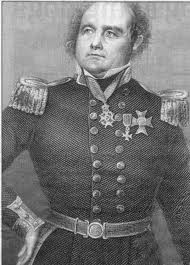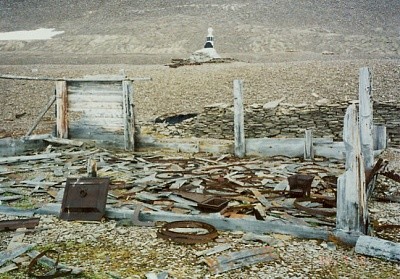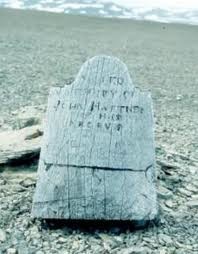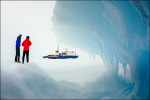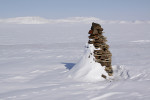Over the Christmas holidays this year the world watched as a ship full of scientists and tourists became entrapped in the ice flows of Antarctica. Even as their rescuers became immobilized by ice, Twitter, Facebook and Skype streams kept us informed of their every thought and activity during the 'ordeal' and allowed us to share even their most mundane experiences. Thankfully the ice may have extended their adventure but not their anxiety. And thankfully there will be no drama-laden memoirs forthcoming and no made-for-TV movies. Without heroism, tragedy, or mystery there will be no reason to commemorate the adventure in song either. That of course was not the case 166 years ago on the opposite end of the world when Sir John Franklin’s two ships disappeared into the Arctic mists. Their fate was left to the imagination and the mystery inspired numerous poems and ballads through the years.
We were homeward
bound one night on the deep
Swinging in my hammock I fell asleep
I dreamed a dream and I thought it true
Concerning Franklin and his gallant crew
Rear-Admiral Franklin was a British Naval officer and Arctic explorer. His fourth and last Arctic voyage was supposed to navigate and chart the last un-navigated section of the Northwest Passage through Canada. Most of the crew were Englishmen, many of them from the North Country, with a small number of Irishmen and Scotsmen. Aside from Franklin the only other officers who had Arctic experience were the captain of his companion ship, an assistant surgeon, and the two ‘ice pilots” - experienced pilots who have charge of a vessel when ice is an obstruction.
With 100 seamen he
sailed away
To the frozen ocean in the month of May
To seek a passage around the pole
Where all poor sailors do sometimes go.
Both ships (HMS Erebus & HMS Terror) were sturdy, modernized vessels that had been designed for Arctic sailing and had been on Arctic expeditions before. They had reinforced bows and retractable rudders. Their internal steam engines enabled them to sail without wind and heat the ship’s interior. Each had food stores to last 3 years.
The expedition was last seen by other
ships in early August 1845 in Baffin Bay.
After two years had passed with no word from Franklin members of Parliament and British
newspapers urged the Admiralty to send out search parties. In the spring of
1848 an overland rescue party went along the MacKenzie
River to the Canadian Arctic coast while two search expeditions
went by sea to the Canadian Arctic. This initial attempt failed but over the
next 166 years other expeditions, explorers, and forensic scientists would
piece together the fate of Lord Franklin and his crew. They would find
campsites, relics, graves, and even handwritten notes. They would receive
information from Inuit Eskimos who had come across the crew. The Erebus
and Terror were never found (however recent expeditions did find the
sunken hulks of vessels that were lost as they searched for Franklin’s crew!) Even into the 21st century,
interest in locating the two ships remains high. Beyond historical curiosity,
evidently finding the final resting place of the ships will in some way be
useful in determining whether Canada has sovereign rights over the passage way or whether it is open international water.
Through cruel
hardships they vainly strove
Their ships on mountains of ice was drove
Only the Eskimo with his skin canoe
Was the only one that ever came through
The two ships had become icebound in Victoria Strait
near King William Island in the Canadian
Arctic in September 1846. The stranded ships were abandoned and Franklin and
his crew of 125 survivors made it to the island where they set up a camp while
awaiting rescue. Over the course of the next two years roughly half the crew
(including Franklin)
died of tuberculosis, scurvy, hypothermia, starvation and lead poisoning (from
improperly sealed tin food containers and the ship’s water distilling system).
The remaining crew members, approximately 40 souls in number, perished sometime after
April 1848 as they attempted to walk to civilization. Most of these died on the
northern coast of the mainland, hundreds of miles from the nearest outpost.
In Baffin's Bay
where the whale fish blow
The fate of Franklin no man may know
The fate of Franklin
no tongue can tell
And Lord Franklin among his seamen do dwell
After the initial 1848 rescue effort
failed, interest in the Arctic and finding Franklin
became a national concern and crusade in Great Britain. Poems and ballads
about the tragedy became widespread. The earliest is called “The Ballad of
Lord John Franklin” and it was published in 1850. Another from that era is
called “Lady Franklin’s Lament.” It is this version that has found its
way into the 21st century and has remained compelling enough to inspire new
versions and derivative songs.
For my Lord Franklin I'd sail the main
Ten thousand pounds I would freely give
To know Lord Franklin, and where he is.
Paul Clayton’s a capella 1954 recording of “Lady Franklin’s Lament” was followed by Martin Carthy’s 1966 finger-picking rendition that has become the modern day standard. Pentangle, Sinéad O'Connor, the Pearlfishers, Mícheál Ó'Domhnaill and John Walsh have all recorded subsequent versions based upon Carthy’s rendition.
Canadian songwriter Stan Rogers also told the story in his composition “Northwest Passage” (1981) which has become one of the most popular songs of the 20th century in Canada. The Irish-American band Nightnoise (featuring Mícheál Ó'Domhnaill) recorded an instrumental called “The Erebus and the Terror’’ on their Windham Hill album “Something of Time” (1987). James Taylor wrote “The Frozen Man” for “New Moon Shine” (1991) after seeing photographs of the excavated permafrost-preserved bodies of Franklin’s seamen. Fairport Convention's "I'm Already There" (2004) is also inspired by the fateful story.
The melody of "Lord Franklin" has also been used by other songwriters as well, most notably by Bob Dylan for "Bob Dylan's Dream" (which he wrote after hearing Martin Carthy perform in an English club), for “Jamie’s Secret” by David Wilcox, and “Cut by Wire” by John Gorka & Geoff Bartley (as recorded by Mary Black).
American Pastimes features the following versions of “Lord Franklin”: Paul Clayton from “Whaling Songs & Ballads” (1954), Craig Bickhardt from “Brother to the Wind” (2011), Martin Carthy from “Second Album” (1966), the Pentangle from "Cruel Sister" (1970).
Stan Rogers performs “Northwest Passage” (1981), and Fairport Convention performs “I’m Already There” from “Over the Next Hill” (2004).
Information Sources: Mostly Wikipedia and Mudcat Cafe.


